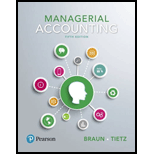
Managerial Accounting (5th Edition)
5th Edition
ISBN: 9780134128528
Author: Karen W. Braun, Wendy M. Tietz
Publisher: PEARSON
expand_more
expand_more
format_list_bulleted
Question
Chapter 1, Problem 1.4SE
To determine
Whether given characteristics pertains directly to internal audit function and specifying its role within organisation.
Expert Solution & Answer
Want to see the full answer?
Check out a sample textbook solution
Students have asked these similar questions
Frick Company began the accounting period with $60,000 of merchandise, and the net cost of purchases was $240,000. A physical inventory count showed $72,000 of merchandise unsold at the end of the period. The cost of goods sold of Frick Company for the period is ?
Hi teacher please help me this question
Hornaek Company
Chapter 1 Solutions
Managerial Accounting (5th Edition)
Ch. 1 - (Learning Objective 1) Which of the following...Ch. 1 - (Learning Objective 2) Managerial accounting...Ch. 1 - (Learning Objective 3) Which of the following...Ch. 1 - (Learning Objective 3) Of the following skills,...Ch. 1 - (Learning Objective 4) Which of the following...Ch. 1 - Prob. 6QCCh. 1 - Prob. 7QCCh. 1 - Prob. 8QCCh. 1 - (Learning Objective 5) Which of the following is...Ch. 1 - (Learning Objective 5) All of the following are...
Ch. 1 - Managers responsibilities (Learning Objective 1)...Ch. 1 - Contrast managerial and financial accounting...Ch. 1 - Prob. 1.3SECh. 1 - Prob. 1.4SECh. 1 - Prob. 1.5SECh. 1 - Prob. 1.6SECh. 1 - Violations of ethical standards (Learning...Ch. 1 - Identify current competitive tools (Learning...Ch. 1 - Identify ethical standards violated (Learning...Ch. 1 - Define key terms (Learning Objectives 1, 2, 3, 4,...Ch. 1 - Define key terms (Learning Objectives 1 2)...Ch. 1 - Prob. 1.12AECh. 1 - Identify users of accounting information (Learning...Ch. 1 - Classify ethical responsibilities (Learning...Ch. 1 - Equipment purchase cost-benefit analysis (Learning...Ch. 1 - Lean production cost-benefit analysis (Learning...Ch. 1 - Identify sustainability efforts as impacting...Ch. 1 - Prob. 1.18BECh. 1 - Prob. 1.19BECh. 1 - Identify users of accounting information (Learning...Ch. 1 - Classify ethical responsibilities (Learning...Ch. 1 - Equipment purchase cost-benefit analysis (Learning...Ch. 1 - Lean production cost-benefit analysis (Learning...Ch. 1 - Prob. 1.24BECh. 1 - Management processes and accounting information...Ch. 1 - Ethical dilemmas (Learning Objective 4) Barb Perot...Ch. 1 - ERP cost-benefit analysis (Learning Objective 5)...Ch. 1 - Online order system cost-benefit analysis...Ch. 1 - Continuation of P1-28A: revised estimates...Ch. 1 - Management processes and accounting information...Ch. 1 - Ethical dilemmas (Learning Objective 4) ETHICS...Ch. 1 - ERP cost-benefit analysis (Learning Objective 5)...Ch. 1 - Online order system cost-benefit analysis...Ch. 1 - Continuation of P1-33B: revised estimates...Ch. 1 - Discuss how managerial accounting can be used at...Ch. 1 - Discussion Questions 1. What are the three main...Ch. 1 - Prob. 1.37ACTCh. 1 - Prob. 1.38ACTCh. 1 - Ethics and casual conversations (Learning...Ch. 1 - Using managerial accounting information to manage...
Knowledge Booster
Similar questions
- Sheffield Corp. determines that 60000 pounds of direct materials are needed for production in July. There are 3,800 pounds of direct materials on hand on July 1 and the desired ending inventory is 3,400 pounds. If the cost per unit of direct materials is $3, what is the budgeted total cost of direct materials purchases?arrow_forwardcost Accountingarrow_forwardAnswer this financial accounting problemarrow_forward
- How much is the direct materials price variance?arrow_forwardDuring its first month of operation, Peter's Auto Supply Corporation, which specializes the sale of auto equipment and supplies, completed the following transactions. July Transactions July 1 Issued Common Stock in exchange for $100,000 cash. July 1 Paid $4,000 rent for the months of July and August July 2 Paid the insurance company $2,400 for a one year insurance policy, beginning July 1. July 5 Purchased inventory on account for $35,000 (Assume that the perpetual inventory system is used.) July 6 Borrowed $36,500 from a local bank and signed a note. The interest rate is 10%, and principal and interest is due to be repaid in six months. July 8 Sold inventory on account for $17,000. The cost of the inventory is $7,000. July 15 Paid employees $6,000 salaries for the first half of the month. July 18 Sold inventory for $15,000 cash. The cost of the inventory was $6,000. July 20 Paid $15,000 to suppliers for the inventory purchased on January 5. July 26…arrow_forward4 Pointsarrow_forward
arrow_back_ios
SEE MORE QUESTIONS
arrow_forward_ios
Recommended textbooks for you
 Auditing: A Risk Based-Approach (MindTap Course L...AccountingISBN:9781337619455Author:Karla M Johnstone, Audrey A. Gramling, Larry E. RittenbergPublisher:Cengage Learning
Auditing: A Risk Based-Approach (MindTap Course L...AccountingISBN:9781337619455Author:Karla M Johnstone, Audrey A. Gramling, Larry E. RittenbergPublisher:Cengage Learning Auditing: A Risk Based-Approach to Conducting a Q...AccountingISBN:9781305080577Author:Karla M Johnstone, Audrey A. Gramling, Larry E. RittenbergPublisher:South-Western College Pub
Auditing: A Risk Based-Approach to Conducting a Q...AccountingISBN:9781305080577Author:Karla M Johnstone, Audrey A. Gramling, Larry E. RittenbergPublisher:South-Western College Pub- Principles of Accounting Volume 2AccountingISBN:9781947172609Author:OpenStaxPublisher:OpenStax College

Auditing: A Risk Based-Approach (MindTap Course L...
Accounting
ISBN:9781337619455
Author:Karla M Johnstone, Audrey A. Gramling, Larry E. Rittenberg
Publisher:Cengage Learning

Auditing: A Risk Based-Approach to Conducting a Q...
Accounting
ISBN:9781305080577
Author:Karla M Johnstone, Audrey A. Gramling, Larry E. Rittenberg
Publisher:South-Western College Pub


Principles of Accounting Volume 2
Accounting
ISBN:9781947172609
Author:OpenStax
Publisher:OpenStax College